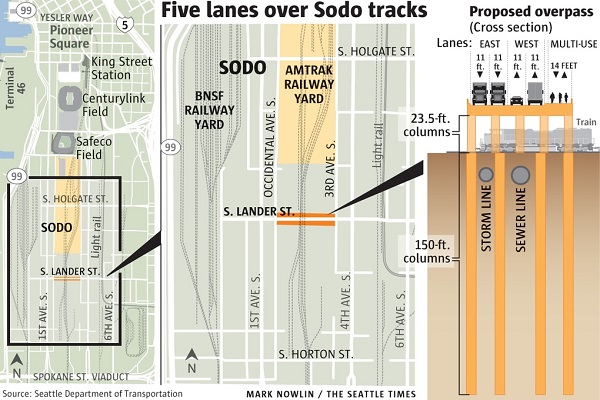20 Apr City seeks federal grant to get Lander overpass moving
A $140 million South Lander Street overpass would include four road lanes and a walk-bike lane, as well as columns that reach 150 feet below ground. The South Lander Street overpass project has been talked about for years, as safety concerns have increased.
By Mike Lindblom, Seattle Times transportation reporter

Sony UPX
Seattle transportation officials have applied for a $55 million federal grant that would revive the long-delayed South Lander Street overpass project, a busy Sodo corridor where trains conflict with commuters and container trucks.
The proposed concrete bridge, going east-west above four pairs of tracks south of the stadiums, has been promoted by Northwest port and trade coalitions since the early 1990’s, and has appeared in statewide freight plans since 1998. About 11,000 vehicles a day cross the tracks at Lander, while 3,200 freight and passenger-rail cars travel the north-south line. The street is closed an average 4 ½ hours a day.
Meanwhile, the safety argument for a separated roadway has increased with the arrival of Safeco Field, oil trains, nightclubs, homeless encampments and Sounder commuter trains.
An average 485 pedestrians and vehicles per day illegally enter the trackway during 100 or so gate closures, according to the city, based on a three-day video sample in January 2016. And over the past five years, 85 crashes have occurred in a three-block stretch — of which one-third could have been prevented by an overpass. Most involved only cars, but two pedestrians were killed by trains and three vehicles were hit by trains, the city says. Yet, amid years of talk, the city, state and Port of Seattle contributed but didn’t fully fund the project.
Mayor Ed Murray took a step toward funding the project, by including $20 million in city property-tax money for Lander, from the $930 million Move Seattle levy voters approved last fall. That left the project still something of a long-shot, in light of estimates as high as $180 million. However, the Seattle Department of Transportation (SDOT) now thinks the project can be completed for $140 million, through leaner engineering, said project director Jessica Murphy. Narrower lanes, and virtually no shoulders, would avoid the need for the city to buy neighboring land. There would be a pair of 11-foot-wide vehicle lanes each direction, as well as a 14-foot walk-bike lane. Concrete columns would plunge 150 feet underground, to reach beyond the former tide flats into hard soil.
Murray’s leadership to endorse a thinner bridge design makes this “a more viable project” with better odds of being built, said Dave Gering, executive director of the Manufacturing Industrial Council. Another advantage in grant competition is that this state has a freight plan, unlike most states, he said.
An additional $30 million for the Lander project would be pieced together from federal, state and BNSF Railway freight programs. It still would need $35 million from various local partners.
Gering said that if the $55 million in federal money arrives, that could encourage the state to boost its contribution, now at $7 million. A grant decision is due in summer. If SDOT wins, design would be finished next year, followed by construction in 2018 and opening in 2019, said Murphy.
Previously, the city included partial funding for Lander in the 2006 Bridging the Gap levy, before then-Mayor Greg Nickels and the City Council shifted money to the Mercer Street and Spokane Street Viaduct rebuilds in 2008.
On the other hand, four flyovers were added this century: the two-lane spiral with wide sidewalks at Royal Brougham Way South, the Edgar Martinez Drive elevated exit, the h-shaped Colorado Avenue South truck overpass to Terminal 46, and the East Marginal Way overpass serving Terminals 5 and 18.
Competition for federal money can tempt cities to make big claims. SDOT’s winning $30 million request for Mercer Streetclaimed a new two-way boulevard “improves flow on Interstate 5 and regional network” and would “allow a new transit route along Mercer.” There is no transit route on Mercer, nor is one proposed.
